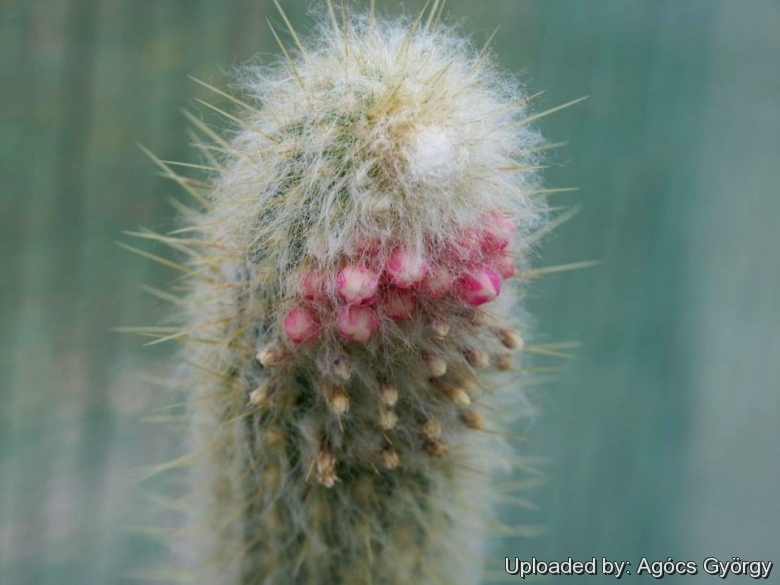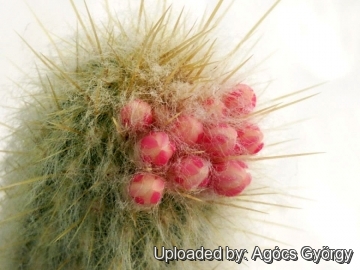Accepted Scientific Name: Micranthocereus polyanthus (Werderm.) Backeb.
Jahrb. Deutsch. Kakteen-Ges. Gray Herb. Card Cat.

Arrojadoa polyantha (Micranthocereus polyanthus) Photo by: Agócs György
Flowering habit. Rebutialand cactus collection Demjén, Hungary.
Origin and Habitat: Micranthocereus polyanthusSN|4871]]SN|4871]] is only known from the municipality of Caetité in southern Bahia, Brazil. It occurs in three locations within a restricted range (extent of occurrence less than 3,000 km2). There are no more than 2,500 mature individuals in total, with less than 250 per subpopulation.
Altitude range: This species grows at elevations of 850 to 1,000 metres above sea level.
Habitat and Ecology: This cactus is an element of the northern campo rupestre, where it is found growing in quartz sand amongst crystalline rocks. Generation length is 10 years. Its population has been reduced by more than 50 percent in the last 30 years due to quarrying of sand, mining, and urbanization. These impacts are not reversible and have not ceased.
Synonyms:
Description: Micranthocereus polyanthusSN|33153]]SN|4871]] is a fascinating slender cactus, the stems being almost completely covered with whitish-yellowish spines, and even more so towards the apex where the pseudocephalium develops and many small rose-red flowers emerge.
Two subspecies are recognized, the nominate form and subsp. alvinii M.Machado & Hofacker, although M. Machado feels the latter should be placed under Micranthocereus flaviflorusSN|4871]]SN|33153]].
Stems: Bluish green, columnar ,branching basally to 1.2 m high, 3.5-5 cm in diameter, almost completely covered with white wool.
Ribs: 15-20, low.
Areoles: Non flowering areoles 1-2 cm apart, with dense white wool hairs 1-2 cm long covering the stem.
Central spines: 3-7, of which 1-3 stronger, golden yellow, light-brown to reddish, to 3 cm long.
Radial spines: 20-30, needle-like, whitish to golden yellow, 05-12 mm long.
Cephalia: Lateral, near the stem tips, not strongly evident, white the wool intermixed with long bristle-like spines.
Flowers: Many, small crowded down one side of the stem, tubular, rose red to pinkish to cream, 1.6-1.8 cm long. Perianth segments erect, 2-3 mm long, the outer pink, the inner creamy-white.
Fruits: 5-7 mm rose red.
Seeds: Blackish.
Bibliography: Major references and further lectures
1) Anderson, Edward F. (2001), "The Cactus Family" Pentland, Oregon: Timber Press
2) Machado, M., Braun, P., Taylor, N.P. & Zappi, D. 2013. Micranthocereus polyanthus. The IUCN Red List of Threatened Species. Version 2015.1. <www.iucnredlist.org>. Downloaded on 09 June 2015.
3) Clive Innes “Complete Handbook of Cacti and Succulents” Van Nostrand Reinhold Company, 01 December 1981
4) E Haustein “Der Kosmos Kakteenfuehrer (the Kosmos Cactus Guide)” Balogh Scientific Books, United States, 01/Dec/1998
5) Stuart Max Walters “European Garden Flora: A Manual for the Identification of Plants Cultivated in Europe, Both Out-of-Doors and Under Glass” Cambridge University Press, 27 lug 1989
6) Nigel P. Taylor, Daniela C. Zappi “Cacti of Eastern Brazil” Royal Botanic Gardens, Kew, 2004
 Buds. Rebutialand cactus collection Demjén, Hungary. (Micranthocereus polyanthus) Photo by: Agócs György
Buds. Rebutialand cactus collection Demjén, Hungary. (Micranthocereus polyanthus) Photo by: Agócs György Opening buds. Rebutialand cactus collection Demjén, Hungary. (Micranthocereus polyanthus) Photo by: Agócs György
Opening buds. Rebutialand cactus collection Demjén, Hungary. (Micranthocereus polyanthus) Photo by: Agócs GyörgyCultivation and Propagation: Micranthocereus polyanthusSN|4871]]SN|4871]] is not particularly difficult on own roots providing it is given a little extra heat during the winter, but this and all its relatives do best when grafted.
Growth rate: It is a relatively rapidly growing and easily flowering species that will make clumps given the best conditions.
Soils: It likes very porous standard cactus mix soil.
Repotting: Use pot with good drainage.
Watering: It should be watered generously during the growing season. Like Cleistocacti, they can exhibit tip die-back if not enough water is given, but do not overwater (Rot prone), keep dry in winter. Water them less than average if in bigger pots, small pots preferred.
Fertilization: Feed with a high potassium fertilizer in summer.
Hardiness: Reputedly sensitive to frost, but less so if kept on the dry side prior to, and during, cold weather. However warmth throughout the year will increase the grower's success (8-12°C during rest season).
Exposition: Outside bright, hot conditions or afternoon shade, inside it needs bright light, and some direct sun. Strong light encourages flowering and heavy wool and spine production.
Uses: It is an excellent plant for container growing. It always looks good and stays small.
Pests & diseases: It may be attractive to a variety of insects, but plants in good condition should be nearly pest-free, particularly if they are grown in a mineral potting-mix, with good exposure and ventilation. Nonetheless, there are several pests to watch for:
- Red spiders: Red spiders may be effectively rubbed up by watering the plants from above.
- Mealy bugs: Mealy bugs occasionally develop aerial into the new growth among the wool with disfiguring results, but the worst types develop underground on the roots and are invisible except by their effects.
- Scales: Scales are rarely a problem.
- Rot: Rot is only a minor problem with cacti if the plants are watered and “aired” correctly. If they are not, fungicides won't help all that much.
Propagation: Division, direct sow after last frost or (often) graft. Seeds germinate in 7-14 days at 21-27° C in spring, remove the glass cover gradually as the plants develops and keep ventilated, no full sun for young plants! To make a cutting twist off a branch and permit it to dry out a couple of weeks, lay it on the soil and insert the stem end partially into the soil. Try to keep the cutting upright so that the roots are able to grow downward.













